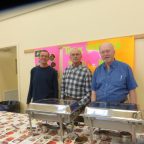Seeing Through Gospel Eyes (March 11, 2018, Lent 4)
Dorothy Day grew up in a household which had no use for organized religion. In her early adult years, she was a political activist. She marched with the suffragettes, and advocated tirelessly for the poor and homeless.
At the age of 30, she converted to Christianity and became a devout Roman Catholic. She continued her activism as she founded the Catholic Worker Movement, whose aim was “to live in accordance with the justice and love of Jesus.”
In her 60’s, she was visiting on a psychiatric ward. A young man named Stephen was visiting a friend when he noticed Dorothy Day come in. There wasn’t anything special about her. She was an elderly woman who looked like anybody’s grandmother. Stephen introduced himself and asked if he might accompany her on her rounds. She quietly took his arm, and they strolled from bed to bed, chatting with each patient.
Suddenly, there was a loud scream. In the doorway, three orderlies were struggling with a new patient. The woman’s hair was tangled, and ugly red scratches scarred her face. She raged and spit on the three men who were trying to subdue her.
Stephen instinctively moved his arm to guide Dorothy Day away, just as he would any woman his grandmother’s age; but it felt as though he were pushing against a rock. Her eyes were fixed on the screaming woman. The attendants dragged her into a padded cell and slammed the door. Then they limped away to nurse their wounds.
The woman kept shrieking.
Dorothy Day walked to the nurses’ station and said, “I want to go in there.”
The head nurse smiled to herself, and never looked up from her chart. She smiled, “Take it easy, ma’am. If you keep talking like that, we might ask you to stay here awhile …”
Just then, a doctor walked onto the ward. Dorothy turned to him and quietly said, “I want to go in there.”
At first, he ignored her; but then he made his mistake—he looked into her eyes. Something in those eyes held him fast. After an awkward moment of silence, he shrugged his shoulders. “Nurse, have her sign a statement releasing the hospital of any responsibility. If that’s what she wants, let her go in.”
The woman was clawing the walls when the cell door swung open. Her face was twisted viciously, but her eyes were strangely blank. She tensed to leap upon the elderly woman who stood in the doorway.
Dorothy Day quietly held out her hand. The woman fell back confused, and Dorothy Day stepped into the centre of the cell. Seconds dragged into minutes; the woman’s screaming slowly subsided to a hoarse whimper. Huddled in the far corner of the little room, she watched the outstretched hand, waiting for it to draw back.
Dorothy continued to hold her hand out. A long time seemed to pass. Slowly … very slowly … the woman reached out and touched the waiting hand.
When they left the hospital, Dorothy Day searched Stephen’s face. “Did you see him?”
Stephen was confused. “Did I see him? Who?”
She smiled gently. “Jesus … there was nobody else in that room.”
I think we find here one of the great truths of our Christian faith: Faith is not just about doing something. Faith is not just about believing something. Faith is not just about becoming a better person.
Faith is also about learning to see in a new way.
It strikes me that our fourth baptismal promise comes close to that understanding:
“Will you seek and serve Christ in all persons, loving your neighbour as yourself?”
The first half of this promise is about learning to see Christ in others. It’s about learning to see Jesus in all the ordinary parts of our lives. It’s about orienting our lives in such a way that we learn to see God in every ordinary and wondrous moment of our lives. It’s about learning to see the world through the gospel eyes given to us by God.
So let me invite you now — look to your right; look to your left; look in front of you; look behind you. Whom do you see?
Sure, we see just another person. We’ve seen him or her many times before. They’re an ordinary part of our lives. A friend. A companion. Someone we know. Someone we get along with. Or don’t.
Look deeper. Can you see here a person who is treasured and cherished by God? Can you see Jesus in this person?
It’s easy to forget that sometimes in the everydayness of our lives. But here is Jesus, right in front of you, right beside you. can we learn to see through gospel eyes?
This is partly how the gospel seeks to change us. The gospel invites us to see the world with the heart of God.
Mostly, it’s pretty easy to do that here, in our pews, in the church building, with people who are mostly like us. But what about out there? Can we see Jesus in the person on the street? in the mall? at the theatre? What about that homeless person begging for some help? Or that stinky alcoholic pushing a grocery cart up the sidewalk? Or that so–and–so who just cut you off on the highway? Or the Trump supporter? Or the one who voted for Trudeau? Or the shrieking woman in the psych ward?
Can we see Jesus in them? In all persons? That’s more of a challenge. Some days, it seems impossible.
But that’s what this question asks us: Will you? Will you let the gospel change the way you see the world?
Let me suggest that when we learn to see the world anew, then the question of serving the Christ in them becomes so much more natural for us.
There’s a blessing I use occasionally at the end of worship: “May the Christ who walks on wounded feet walk with you to the end of the road. May the Christ who serves with wounded hands teach you to serve each other. May the Christ who loves with a wounded heart open your hearts to love. May you see the face of Christ in everyone you meet, and may everyone you meet see the face of Christ in you.”
Will you?
See Jesus?
In all persons?
I’d like to take it a step further … will we recognize God in each living thing? Will we recognize the divine in everything around us? But that’s a whole other sermon.
Our baptism invites us to be transformed.
The first question invites us to be deeply involved in community, in worshipping together and opening ourselves to God’s spirit in our lives.
The second question invites us to resist evil, and to align ourselves with God’s gospel purposes.
The third question invites us to imagine ourselves as part of the story of God’s grand adventure in the world.
This fourth question invites us to learn to see the world with the heart of God.
All of these baptismal promises drive us beyond ourselves to see the needs of the world. They drive us to see the world with the eyes of God and to feel with the compassionate heart of God. They drive us to love deeply.
And our response is that we will seek to learn to see with new eyes, to love with a renewed heart, to embrace with a new joy.
“Will you seek and serve Christ in all persons, loving your neighbour as yourself?”
I will, with God’s help.
Thanks be to God.
Rev. Dr. Yme Woensdregt
March 11, 2018 (4th Sunday in Lent)
John 3: 14–21
Ephesians 2: 1–10
Numbers 21: 4–9







